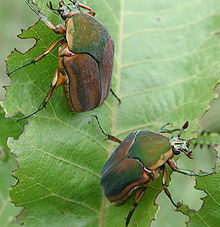- Cotinis nitida
-
Cotinis nitida 
Scientific classification Kingdom: Animalia Phylum: Arthropoda Class: Insecta Order: Coleoptera Family: Scarabaeidae Subfamily: Cetoniinae Tribe: Gymnetini Genus: Cotinis Species: C. nitida Binomial name Cotinis nitida
(Linnaeus, 1758)Cotinis nitida, also known as the green beetle, is a beetle of the family Scarabaeidae. It occurs in the southeastern part of the United States. It is not easily distinguished from the related southwestern species, Cotinis mutabilis.
The green beetle is active during daylight hours. The adult is usually 15–22 mm (0.59–0.87 in) long with dull, metallic green wings; its sides are gold and the head, legs and underside are very bright shiny green. Their habitat extends from Maine to Georgia, and as far west as Kansas, with possible population crossover in Texas with their western cousin, the figeater beetle.
Life cycle
The complete life cycle for the green beetle is one year. Once the mating process has taken place, the female will lay between 60 and 75 eggs underground during a two week period. The eggs, when first laid, appear white and elliptical in shape, gradually becoming more spherical as the larvae develop. The eggs hatch in approximately 18 days into small, white grubs. The grubs will grow to about 40mm and appear to be white with a brownish-black head and brown spiracles along the sides of the body. The larvae will molt twice before winter. Pupation occurs after the third larval stage, which lasts nearly nine months. The adults begin to appear in June after 18 days of the pupation period.
The green beetle is harmless; however, the larvae are considered pests when they cause damage to lawns.
This Scarabaeidae-related article is a stub. You can help Wikipedia by expanding it.
